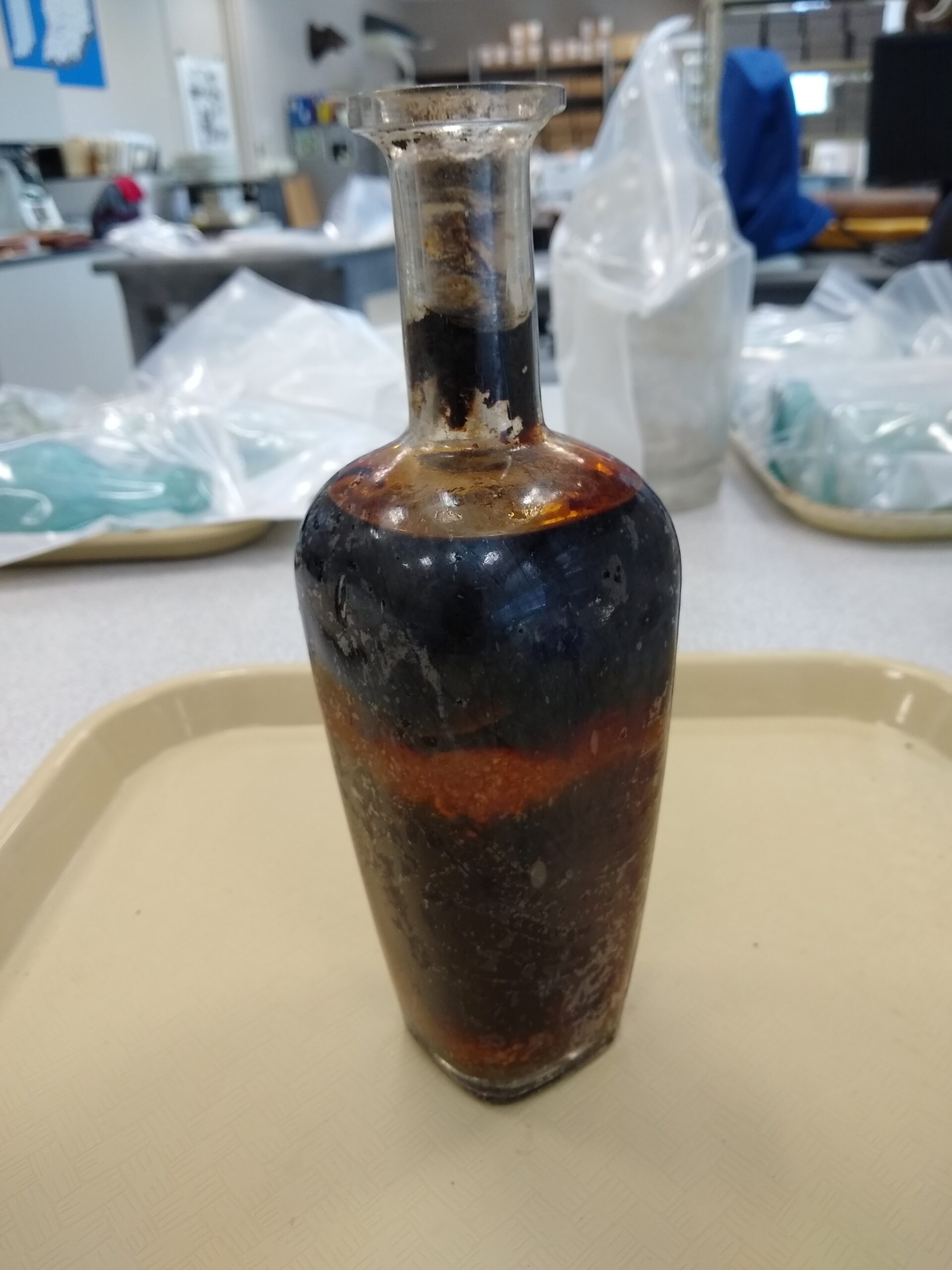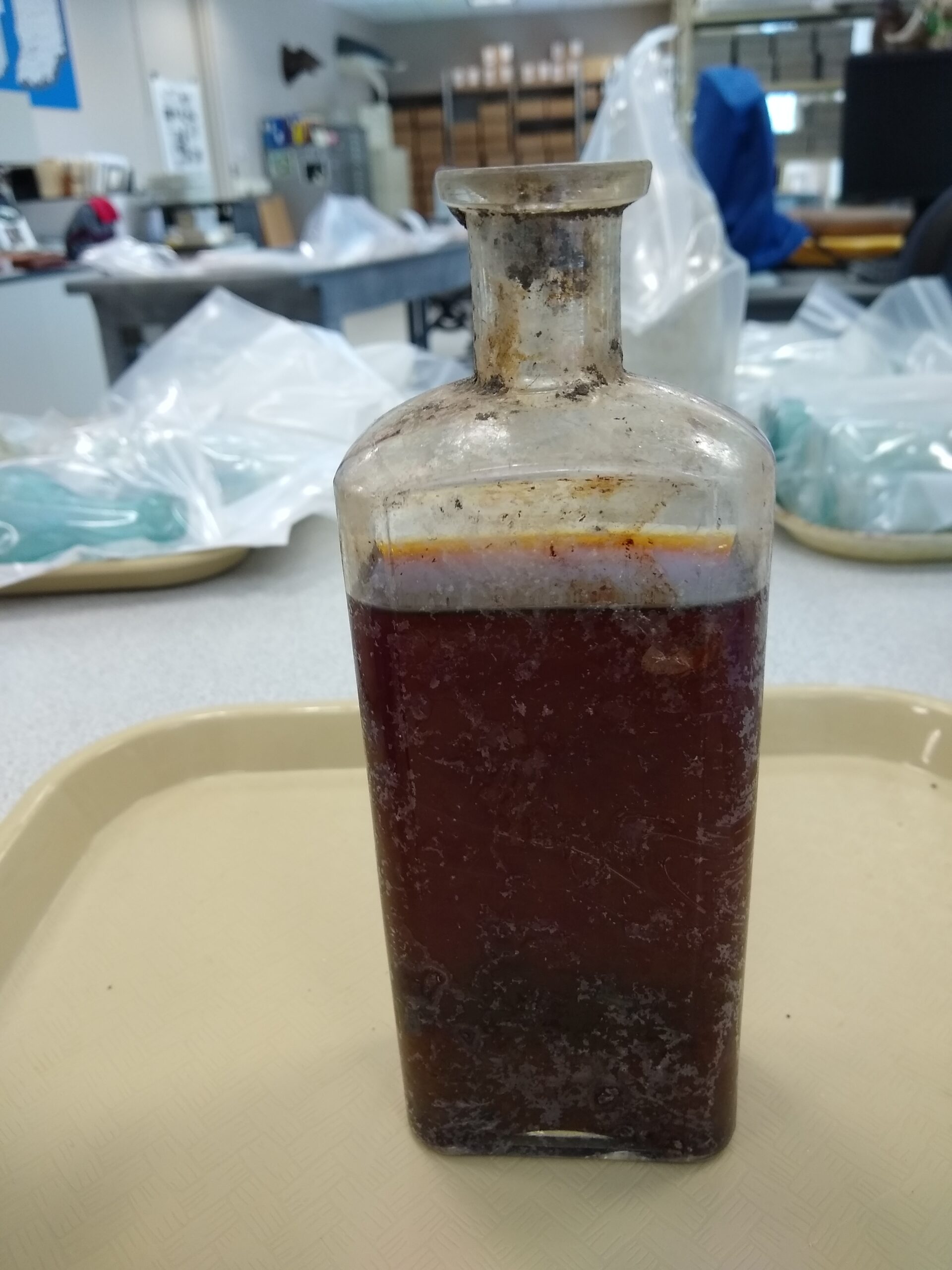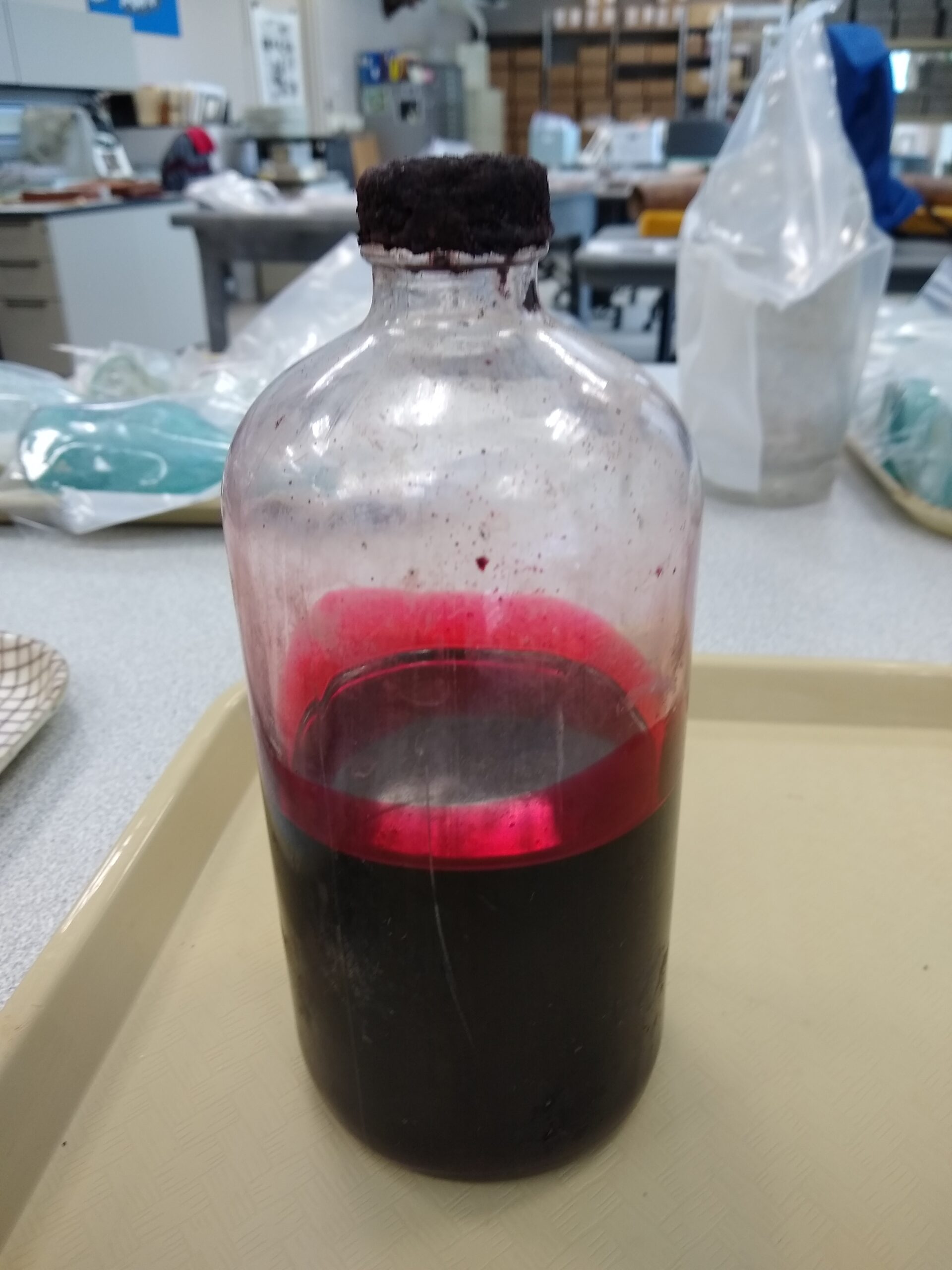Published September 28, 2021
The Transit Center Mystery Bottles
By Gail Brown, Indiana State Museum and Historic Sites archaeology specialist
When working on an archaeological site, odds are typically against finding an unbroken bottle – let alone a complete bottle still sealed with the original contents inside. However, museum staff recently discovered four sealed bottles containing their original liquids in one of our archaeological collections from the Julia M. Carson Transit Center in downtown Indianapolis.
This is cool on one hand, but potentially hazardous on the other.
The site was excavated in 2015, and the collection consists of thousands of artifacts that reflect everyday life in Indianapolis throughout the 19th and 20th centuries – including those four sealed bottles with liquid inside.
Although the bottles and liquids can provide a unique perspective on what was occurring at the site, they can also provide a challenge to preserving the collection.
After all, what is the liquid? Is it harmful, poisonous, acidic, flammable, or worse – explosive? What kind of harm can the liquid bring to the artifacts and staff? Will fumes from the liquid cause illness? Will it cause damage to other artifacts? Should we get rid of it? How do we get rid of it safely? Should we preserve the liquid?
As we wrestled with these questions and others, it became clear that to safely deal with the bottles and mystery liquids, we needed to identify the liquid inside. The identification process began by examining the bottles and any clues they possess.
Do they have any identifying labels or markings? Do they have unique shapes or designs that can be tracked down?

One bottle had the mark “Gallo Flavor Guard Glass.” The bottle also had a design that matched with other examples. The liquid was a deep, dark red with a lot of sediment on the bottom.
Putting those clues together, we identified what we have as a 1960s Gallo wine bottle with contents that are NOT harmful and can be left for future generations to sample 20th-century wine.
OK – one down and three to go.
Although a few of the bottles had embossed maker’s marks on their bases, we were unable to identify the manufacturer for three.
Our other bottles still held onto their secrets.

Bottle: 71.19.1419.2832
Embossed “PD & Co; 347” on base; could also be PO & Co. “PD & Co” refers to Parke-Davis & Company, a pharmaceutical company in Detroit from 1871-1970. However, the bottle does not match any other PD & Co bottles in preliminary searches. The bottle contents appear to be separated salad dressing.
The bottle was discovered in Feature 60 – an area that has been interpreted as a privy, or outhouse toilet, from the mid- to late-19th century. Most artifacts from the feature highlight domestic use, including beverage bottles, tableware and personal items.
The privy is associated with the address 23-25 S. Delaware St., which housed over time:
1858 – 1864 – Boarding House
1866 – 1869 – Livery Stable
1871 – 1878 – Dietz & Reissner tanner, currier, leather
1885 – 1928 – Variety of Commission Merchants
1905 – Saloon
1928 – 1941 – Furniture Company
1941 – Parking lot
Bottle: 71.19.1419.2233.2
Embossed with a “5” on the base, this bottle is unidentified. Within the report, the authors refer to the bottle as “Based on the paneled-sided shape, it is a medicine bottle. This bottle has no basal maker’s mark or embossed lettering indicating what the contents could be.”
The bottle is from Feature 9, a privy associated with the address 19 S. Delaware St. Most objects from the feature were domestic in nature; however, several additional medicinal bottles were recovered.
Functions associated with 19 S. Delaware St.:
1855 – Bagley and Everts wholesale grocery
1866 – F.J. Hermann, an undertaker
1869 – flour and feed store
1870 – Conrad Livery Sale and Feed Stable
1885 – commission merchants / produce dealer
1905 – Woodruff & Co. Oysters, Fish and Game Commission
1941 – parking lot


Bottle: 71.19.1419.4055
This bottle is embossed with a “D ; 8-8 4688 A” within either a square or keystone. This liquid has a higher viscosity than the other bottles – like cough syrup. The object was surface collected from the site and is not associated with any one address. However, it was recovered from the southwest quadrant of the site, which included many of the businesses mentioned above. No further information was found within the excavation report.
To fully examine the remaining liquids, the museum partnered with the Forensic and Investigative Sciences Program at IUPUI.
Dr. John Goodpaster, associate director of the Forensic and Investigative Sciences Program, and his students volunteered to analyze the contents. Students would have to approach the historic bottles with the same care and attention to detail as they would a modern-day crime scene.
Goodpaster mentioned that crime scene technicians can come across scenes that contain bottles filled with unknown liquids. This opportunity provided a great case study, but without the nefarious back story.
Students ran a range of tests, each looking at components of the liquid to narrow down the individual compounds.
After the battery of tests, their conclusions were:

Bottle: 71.19.1419.2832
The contents, including several long-chain fatty acids, are consistent with separated salad dressing that has gone rancid due to the presence of butanoic acid.
With this new evidence, combined with the maker’s mark, perhaps we can further trace the salad dressing to a particular brand. This could provide us with greater details to determine the date of the bottle and add to our understanding of the socio-economic workings of the site and its residents.
Bottle: 71.19.1419.2233.2
The contents are an aqueous solution that contains several organic compounds, including a yellow colorant Solvent Yellow 1.


Bottle: 71.19.1419.4055
The contents are a corrosive/acidic liquid with an acrid odor due to the presence of acetic acid, phenol, and phthalic anhydride – the red dye remains unidentified.
But those last two liquids haven’t spilled their secrets yet. The compounds in these liquids can be used in a wide variety of applications, from food and plastics to cleaners and dyes.
Goodpaster and his team have reached out to other partners to continue the research. Not only will their conclusions help us understand what we have, but how to preserve the liquid – or to safely dispose of it. We also hope their findings add to our understanding of the site and what occurred there. We will let you know what we learn.
The Indiana State Museum and Historic Sites would like to thank the IUPUI Forensic and Investigative Sciences Program, Dr. John Goodpaster, Courtney Cruse, Kymeri David and Madison Reavis.









